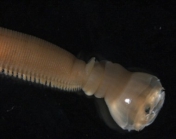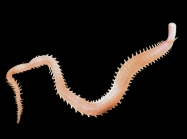
| About | | Search taxa | | Taxon tree | | Search literature | | Checklist | | Stats | | Log in |
WoRMS taxon detailsGlycera alba (O.F. Müller, 1776)
130116 (urn:lsid:marinespecies.org:taxname:130116)
accepted
Species
Glycera albicans Quatrefages, 1850 · unaccepted (subjective synonym)
Glycera branchialis Quatrefages, 1866 · unaccepted (subjective synonym)
Glycera danica Quatrefages, 1866 · unaccepted (subjective synonym)
Glycera minuta (Bobretzky, 1870) · unaccepted (superseded combination)
Glycera minuta sevastopolica Czerniavsky, 1881 · unaccepted (subjective synonym)
Glycera minuta suchumica Czerniavsky, 1881 · unaccepted (subjective synonym)
Nereis alba Müller, 1776 · unaccepted (superseded original combination)
Rhynchobolus minutus Bobretzky, 1870 · unaccepted (subjective synonym)
marine,
recent only
(of Nereis alba Müller, 1776) Müller, O.F. (1776). Zoologiae Danicae Prodromus, seu Animalium Daniae et Norvegiae Indigenarum characters, nomina, et synonyma imprimis popularium. <em>Typis Hallageriis, Havniae.</em> 32: 1-282., available online at http://www.biodiversitylibrary.org/item/47550
page(s): 217 (species number 2634) [details]
Type locality contained in Norwegian Exclusive Economic Zone
type locality contained in Norwegian Exclusive Economic Zone [from synonym] [view taxon] [details]
Description Medium-sized (up to 75 mm long) bristle worm whose body narrows towards both ends. The eversible proboscis has papillae and...
Description Medium-sized (up to 75 mm long) bristle worm whose body narrows towards both ends. The eversible proboscis has papillae and four jaws. The antennae are very small. Segments are subdivided into rings. Small parapodia with clear gills. Colour: milk white. [details] Distribution In the 1976-1986 period Glycera alba was only found twice (western coastal zone; maximum 4 ind./m2). In the 1994-2001 period...
Distribution In the 1976-1986 period Glycera alba was only found twice (western coastal zone; maximum 4 ind./m2). In the 1994-2001 period the species was more widely distributed and was mainly found in the western near-coastal zone. Glycera alba was observed only sporadically in the open sea zone. In this period the species reached a maximum density of 100 ind./m2. [details] Distribution Distribution: Indian Ocean, India, Red Sea, atlantic Ocean. (Fauvel,1957).
Distribution Distribution: Indian Ocean, India, Red Sea, atlantic Ocean. (Fauvel,1957). [details] Distribution Bay of Fundy; Iceland; North Sea; English Channel; France; Mediterranean
Distribution Bay of Fundy; Iceland; North Sea; English Channel; France; Mediterranean [details]
Read, G.; Fauchald, K. (Ed.) (2025). World Polychaeta Database. Glycera alba (O.F. Müller, 1776). Accessed through: World Register of Marine Species at: https://www.marinespecies.org/aphia.php?p=taxdetails&id=130116 on 2025-07-17
Date action by
Nomenclatureoriginal description
(of Glycera albicans Quatrefages, 1850) Quatrefages, Armand de. (1850). Études sur les types inférieurs de l'embranchement des annelés. Mémoire sur le système nerveux des annélides proprement dites. <em>Annales des sciences naturelles, Paris.</em> Série 3, 14: 329-398, plates 6-10., available online at http://www.biodiversitylibrary.org/page/13433776 page(s): 358, plate 9 fig. IV [details] original description (of Glycera danica Quatrefages, 1866) Quatrefages, A. de. (1866 (1865)). Histoire naturelle des Annelés marins et d'eau douce. Annélides et Géphyriens. <em>Librarie Encyclopédique de Roret. Paris.</em> <b>Volume 1.</b> 1-588., available online at http://books.google.com/books?id=FV9IAAAAYAAJ [details] original description (of Rhynchobolus minutus Bobretzky, 1870) Bobretzky, N. (1870). [Materials to the fauna of the Black Sea (Annelida Polychaeta)]. [Original] Матерiалы для фауны чернаго моря Аннелиды (Annelida, Polychaeta) / Materialy dlya fauny Chernogo morya (Annelida, Polychaeta). <em>Zapiski Kievskago obshchestva estestvoispytateleĭ [Mémoires de la Société des Naturalistes de Kiew].</em> 1: 188-274, plates 9-12. [details] original description (of Glycera branchialis Quatrefages, 1866) Quatrefages, A. de. (1866 (1865)). Histoire naturelle des Annelés marins et d'eau douce. Annélides et Géphyriens. <em>Librarie Encyclopédique de Roret. Paris.</em> <b>Volume 1.</b> 1-588., available online at http://books.google.com/books?id=FV9IAAAAYAAJ [details] original description (of Nereis alba Müller, 1776) Müller, O.F. (1776). Zoologiae Danicae Prodromus, seu Animalium Daniae et Norvegiae Indigenarum characters, nomina, et synonyma imprimis popularium. <em>Typis Hallageriis, Havniae.</em> 32: 1-282., available online at http://www.biodiversitylibrary.org/item/47550 page(s): 217 (species number 2634) [details] original description (of Glycera minuta sevastopolica Czerniavsky, 1881) Czerniavsky, Voldemaro. (1881). Materialia ad zoographiam Ponticam comparatam. Fasc. III Vermes [Second part]. <em>Bulletin de la Société Impériale des Naturalistes de Moscou (= Byulletin' Moskovskogo obshchestva ispytatelei prirody).</em> 56(2): 338-420, 1 plate., available online at https://biodiversitylibrary.org/page/41340542 [details] original description (of Glycera minuta suchumica Czerniavsky, 1881) Czerniavsky, Voldemaro. (1881). Materialia ad zoographiam Ponticam comparatam. Fasc. III Vermes [Second part]. <em>Bulletin de la Société Impériale des Naturalistes de Moscou (= Byulletin' Moskovskogo obshchestva ispytatelei prirody).</em> 56(2): 338-420, 1 plate., available online at https://biodiversitylibrary.org/page/41340542 [details] basis of record Bellan, G. (2001). Polychaeta, <i>in</i>: Costello, M.J. <i>et al.</i> (Ed.) (2001). European register of marine species: a check-list of the marine species in Europe and a bibliography of guides to their identification. <em>Collection Patrimoines Naturels.</em> 50: 214-231. (look up in IMIS) [details] new combination reference Rathke, H. (1843). Beiträge zur Fauna Norwegens. [Contributions to the Fauna of Norway]. <em>Nova Acta Academiae Caesareae Leopoldino-Carolinae Naturae Curiosorum, Breslau & Bonn.</em> 20: 1-264., available online at https://doi.org/10.5962/bhl.title.11613 page(s): 173-174, plate IX fig. 9 [details] Taxonomyredescription
Jirkov, I.A. (2001). [Polychaeta of the Arctic Ocean] (In Russian) Polikhety severnogo Ledovitogo Okeana. Yanus-K Press, Moscow, 632 pp., available online at https://www.researchgate.net/publication/259865957_Jirkov_2001_Polychaeta_of_the_North_Polar_Basin [details] Available for editors redescription Imajima, Minoru. (2003). Polychaetous Annelids from Sagami Bay and Sagami Sea collected by the Emperor Showa of Japan and deposited at the Showa Memorial Institute, National Science Museum, Tokyo (II). Orders included within the Phyllodocida, Amphinomida, Spintherida and Eunicida. <em>National Science Museum Monographs.</em> 23: 1-221., available online at https://ci.nii.ac.jp/naid/110004708004 [details] Available for editors Othercontext source (HKRMS)
Shin, Paul K. S. (1982). The macrobenthic infauna of Tolo Harbour and Tolo Channel , Hong Kong. <em>[Edited book chapter. Workshop proceedings].</em> Proceedings of the first international marine biological workshop: The marine flora and fauna of Hong Kong and southern China (ed. Morton, B.), vol. 2, pp721-732. Hong Kong University Press, Hong Kong. [details] Available for editors
context source (Schelde) van Eck, G. Th. M.; Holzhauer, H. (2007). Monitoring van de effecten van de verruiming 48'/43': MOVE eindrapport 2006 (Rapport 10). <em>Rapport RIKZ = Report RIKZ, 2007.003. RIKZ: Middelburg.</em> 64 pp. (look up in IMIS) [details] context source (BeRMS 2020) Bio-environmental research group; Institute of Agricultural and Fisheries research (ILVO), Belgium; (2015): Macrobenthos monitoring in function of the Water Framework Directive in the period 2007-2009. [details] additional source Pocklington, P. (1989). Polychaetes of eastern Canada. An illustrated key to polychaetes of eastern Canada including the eastern Arctic. <em>Deparment of Fisheries and Oceans.</em> 1-274. [details] additional source Day, J. H. (1967). [Errantia] A monograph on the Polychaeta of Southern Africa. Part 1. Errantia. British Museum (Natural History), London. pp. vi, 1–458, xxix., available online at http://www.biodiversitylibrary.org/bibliography/8596 [details] additional source Muller, Y. (2004). Faune et flore du littoral du Nord, du Pas-de-Calais et de la Belgique: inventaire. [Coastal fauna and flora of the Nord, Pas-de-Calais and Belgium: inventory]. <em>Commission Régionale de Biologie Région Nord Pas-de-Calais: France.</em> 307 pp., available online at http://www.vliz.be/imisdocs/publications/145561.pdf [details] additional source Integrated Taxonomic Information System (ITIS). , available online at http://www.itis.gov [details] additional source Hartmann-Schröder, G. (1996). Annelida, Borstenwürmer, Polychaeta [Annelida, bristleworms, Polychaeta]. <em>2nd revised ed. The fauna of Germany and adjacent seas with their characteristics and ecology, 58. Gustav Fischer: Jena, Germany. ISBN 3-437-35038-2.</em> 648 pp. (look up in IMIS) [details] Available for editors additional source Fauvel, P. (1923). Polychètes errantes. Faune de France. <em>Librairie de la Faculte des Sciences. Paris.</em> 5: 1-488., available online at http://www.faunedefrance.org/ [details] additional source Grube, Adolf Eduard. (1850). Die Familien der Anneliden. <em>Archiv für Naturgeschichte, Berlin.</em> 16(1): 249-364., available online at https://biodiversitylibrary.org/page/6958350 [details] additional source Izuka, Akira. (1912). The errantiate Polychaeta of Japan. <em>Journal of the College of Science, Imperial University of Tokyo.</em> 30(2): 1-262, plates I-XXIV., available online at https://biodiversitylibrary.org/page/39205921 page(s): 247-248, plate XXIII figs. 8-9 [details] additional source Malmgren, A.J. (1867). Annulata Polychaeta Spetsbergiæ, Grœnlandiæ, Islandiæ et Scandinaviæ. Hactenus Cognita. Ex Officina Frenckelliana, Helsingforslæ. 127 pp. & XIV plates., available online at http://www.biodiversitylibrary.org/bibliography/13358 [details] additional source Liu, J.Y. [Ruiyu] (ed.). (2008). Checklist of marine biota of China seas. <em>China Science Press.</em> 1267 pp. (look up in IMIS) [details] Available for editors  Present Present  Present in aphia/obis/gbif/idigbio Present in aphia/obis/gbif/idigbio  Inaccurate Inaccurate  Introduced: alien Introduced: alien  Containing type locality Containing type locality
Unreviewed
Description Medium-sized (up to 75 mm long) bristle worm whose body narrows towards both ends. The eversible proboscis has papillae and four jaws. The antennae are very small. Segments are subdivided into rings. Small parapodia with clear gills. Colour: milk white. [details]Distribution In the 1976-1986 period Glycera alba was only found twice (western coastal zone; maximum 4 ind./m2). In the 1994-2001 period the species was more widely distributed and was mainly found in the western near-coastal zone. Glycera alba was observed only sporadically in the open sea zone. In this period the species reached a maximum density of 100 ind./m2. [details] Distribution Distribution: Indian Ocean, India, Red Sea, atlantic Ocean. (Fauvel,1957). [details] Distribution Bay of Fundy; Iceland; North Sea; English Channel; France; Mediterranean [details] Habitat Glycera alba prefers sediments with a median grain size of 50 to 250 μm but is also found in coarser sediments (up to 500 μm). The species furthermore tends to prefer sediments with a mud content of 10-20%. The high relative occurrence in sediments with a mud content of 40-50% is considered unreliable. [details] Habitat Prefers mud and sand substrate; found in the littoral and sublittoral zone [details] Remark Fauvel (1953) and MacNae & Kalk (1962) describe the species as Glycera alba Rathke. [details]
To Barcode of Life (11 barcodes)
To Biodiversity Heritage Library (10 publications) (from synonym Glycera albicans Quatrefages, 1850) To Biodiversity Heritage Library (120 publications) To Biodiversity Heritage Library (3 publications) (from synonym Glycera minuta (Bobretzky, 1870)) To Biological Information System for Marine Life (BISMaL) To European Nucleotide Archive, ENA (Glycera alba) To GenBank (18 nucleotides; 11 proteins) (from synonym Glycera minuta (Bobretzky, 1870)) To GenBank (18 nucleotides; 11 proteins) To Global Biotic Interactions (GloBI) To NHMUK collection (Glycera alba (Müller, 1788); NON-TYPE; NHMUK:ecatalogue:9473959) To PESI To PESI (from synonym Glycera minuta (Bobretzky, 1870)) To USNM Invertebrate Zoology Annelida Collection (5 records) To ITIS |



